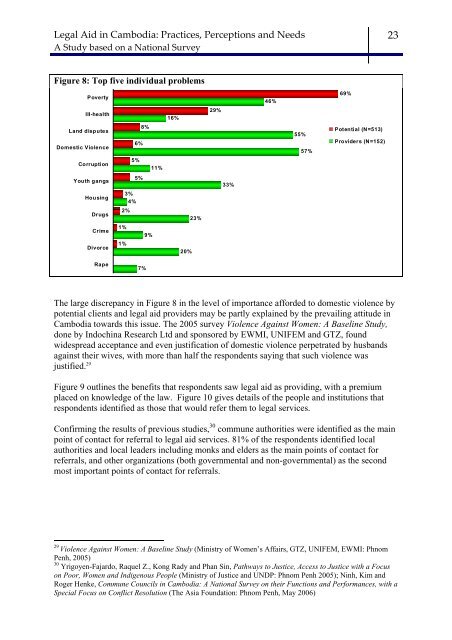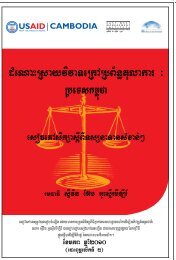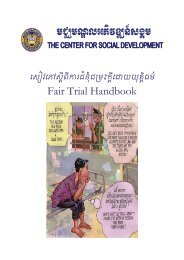Legal Aid in Cambodia: Practices, Perceptions and Needs - PRAJ
Legal Aid in Cambodia: Practices, Perceptions and Needs - PRAJ
Legal Aid in Cambodia: Practices, Perceptions and Needs - PRAJ
Create successful ePaper yourself
Turn your PDF publications into a flip-book with our unique Google optimized e-Paper software.
<strong>Legal</strong> <strong>Aid</strong> <strong>in</strong> <strong>Cambodia</strong>: <strong>Practices</strong>, <strong>Perceptions</strong> <strong>and</strong> <strong>Needs</strong> 23A Study based on a National SurveyFigure 8: Top five <strong>in</strong>dividual problemsPoverty46%69%III-health16%29%L<strong>and</strong> disputesDomestic Violence8%6%55%57%Potential (N=513)Providers (N=152)Corruption5%11%Youth gangs5%33%Hous<strong>in</strong>g3%4%Drugs2%23%CrimeDivorce1%1%9%20%Rape7%The large discrepancy <strong>in</strong> Figure 8 <strong>in</strong> the level of importance afforded to domestic violence bypotential clients <strong>and</strong> legal aid providers may be partly expla<strong>in</strong>ed by the prevail<strong>in</strong>g attitude <strong>in</strong><strong>Cambodia</strong> towards this issue. The 2005 survey Violence Aga<strong>in</strong>st Women: A Basel<strong>in</strong>e Study,done by Indoch<strong>in</strong>a Research Ltd <strong>and</strong> sponsored by EWMI, UNIFEM <strong>and</strong> GTZ, foundwidespread acceptance <strong>and</strong> even justification of domestic violence perpetrated by husb<strong>and</strong>saga<strong>in</strong>st their wives, with more than half the respondents say<strong>in</strong>g that such violence wasjustified. 29Figure 9 outl<strong>in</strong>es the benefits that respondents saw legal aid as provid<strong>in</strong>g, with a premiumplaced on knowledge of the law. Figure 10 gives details of the people <strong>and</strong> <strong>in</strong>stitutions thatrespondents identified as those that would refer them to legal services.Confirm<strong>in</strong>g the results of previous studies, 30 commune authorities were identified as the ma<strong>in</strong>po<strong>in</strong>t of contact for referral to legal aid services. 81% of the respondents identified localauthorities <strong>and</strong> local leaders <strong>in</strong>clud<strong>in</strong>g monks <strong>and</strong> elders as the ma<strong>in</strong> po<strong>in</strong>ts of contact forreferrals, <strong>and</strong> other organizations (both governmental <strong>and</strong> non-governmental) as the secondmost important po<strong>in</strong>ts of contact for referrals.29Violence Aga<strong>in</strong>st Women: A Basel<strong>in</strong>e Study (M<strong>in</strong>istry of Women’s Affairs, GTZ, UNIFEM, EWMI: PhnomPenh, 2005)30 Yrigoyen-Fajardo, Raquel Z., Kong Rady <strong>and</strong> Phan S<strong>in</strong>, Pathways to Justice, Access to Justice with a Focuson Poor, Women <strong>and</strong> Indigenous People (M<strong>in</strong>istry of Justice <strong>and</strong> UNDP: Phnom Penh 2005); N<strong>in</strong>h, Kim <strong>and</strong>Roger Henke, Commune Councils <strong>in</strong> <strong>Cambodia</strong>: A National Survey on their Functions <strong>and</strong> Performances, with aSpecial Focus on Conflict Resolution (The Asia Foundation: Phnom Penh, May 2006)









